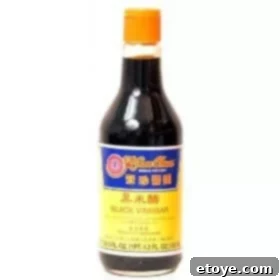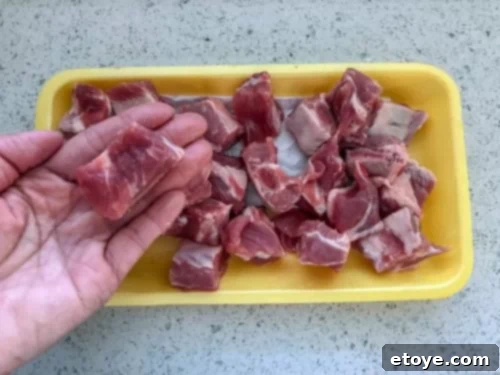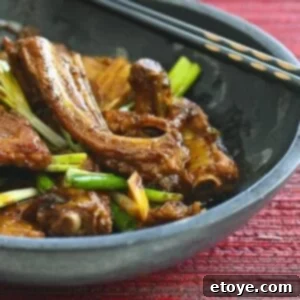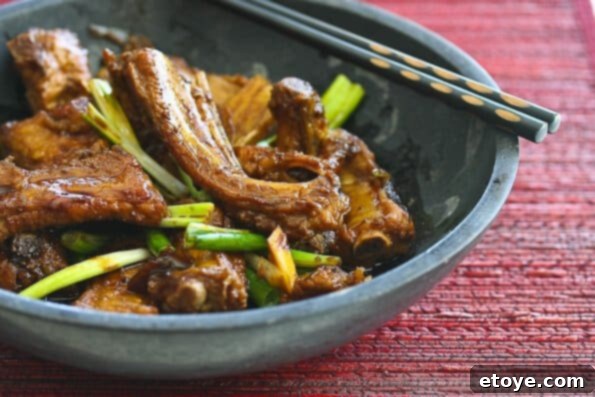Mastering Authentic Chinese Sweet and Sour Spare Ribs: A No-Deep-Fry Recipe
Embark on a culinary adventure from the comfort of your kitchen with this incredible recipe for Chinese Sweet and Sour Spare Ribs, also known as Tang Cu Pai Gu. This iconic dish is not just a delightful appetizer but a truly satisfying main course, especially when paired with a cold beverage. While traditional recipes often call for deep-frying the ribs to achieve that signature crispy exterior, our adapted version offers a healthier, less messy alternative without sacrificing an ounce of flavor. Forget the hassle of managing large quantities of hot oil; we’ll guide you through a technique that yields tender, succulent ribs coated in a perfectly balanced sweet and sour glaze, making this classic accessible to every home cook.
The Culinary Wisdom of Fushia Dunlop: A Guide to Authentic Chinese Flavors
Our journey to perfect these Sweet and Sour Spare Ribs leads us to the esteemed work of Fushia Dunlop, a renowned food writer and chef celebrated for her profound understanding of Chinese regional cuisines. Her book, Revolutionary Chinese Cookbook: Recipes from Hunan Province, provided the inspiration for this particular method, proving that authentic flavors can be achieved through diverse cooking techniques. Dunlop’s dedication to researching and presenting genuine Chinese recipes makes her an invaluable resource for anyone passionate about this vibrant culinary tradition. Upon discovering her meticulously researched and truly authentic approach, I immediately sought out her works, including Land of Plenty: A Treasury of Authentic Sichuan Cooking. For any enthusiast of Chinese cuisine, both books are indispensable additions to your cookbook collection. They offer not just recipes but a deep dive into the cultural context and nuanced flavors that define these regional styles. Ms. Dunlop has also penned a captivating memoir, which I eagerly anticipate exploring when time allows, further showcasing her unique connection to Chinese food and culture.
Fushia Dunlop’s impact on making regional Chinese cuisine accessible to a Western audience cannot be overstated. Her books are more than just collections of recipes; they are ethnographic studies, offering insights into the history, ingredients, and techniques that make dishes like Sweet and Sour Spare Ribs so special. She demystifies complex preparations and introduces readers to a world beyond the common takeout menu, encouraging a deeper appreciation for the diversity and sophistication of Chinese cooking. Her authentic approach ensures that when you cook from her books, you’re not just following instructions, but genuinely connecting with the culinary traditions of China.
Essential Ingredients: Decoding Key Flavors for Your Sweet and Sour Ribs
The magic of Chinese Sweet and Sour Spare Ribs lies in the harmonious blend of its core ingredients. To truly capture the authentic essence of this dish, understanding these components is key. Let’s delve into two vital elements that elevate this recipe beyond the ordinary: dark soy sauce and Chinese black vinegar.
The Depth of Dark Soy Sauce
It’s crucial to distinguish between dark soy sauce and your everyday regular soy sauce. Dark soy sauce, often labeled as “Thick Soy Sauce” or simply “Dark Soy Sauce,” is a unique ingredient that plays a pivotal role in many Chinese dishes, especially those requiring a rich color and a subtle sweetness. Unlike its lighter counterpart, dark soy sauce is more intense in flavor, notably sweeter, and surprisingly less salty. This distinct profile comes from the addition of molasses during its fermentation process, which also gives it a darker hue and a slightly thicker consistency. Its primary function in cooking is not just to add saltiness, but to impart a beautiful, deep reddish-brown color to braised meats, stir-fries, and, of course, our sweet and sour ribs. It contributes a complex, umami depth that regular soy sauce cannot replicate, making it an indispensable component for authentic results. Look for it in Asian grocery stores; a good quality dark soy sauce will significantly impact the visual appeal and flavor of your dish.
The Tang of Chinese Black Vinegar

No discussion of Sweet and Sour Spare Ribs is complete without highlighting Chinese black vinegar. This essential ingredient is the very soul of the “sour” element in our recipe, providing a complex tang that is far removed from the sharp acidity of Western vinegars. The most highly prized Chinese black vinegar originates from Zhenjiang (formerly Chinkiang) Province, renowned for its malty, smoky, and slightly sweet undertones. It’s made from glutinous rice and other grains, aged to develop its distinctive flavor profile, which adds a wonderful depth to the sauce. Beyond sweet and sour dishes, it’s a versatile condiment in Chinese cuisine. My family, for instance, enjoys drizzling a tiny spoonful into my Mom’s Famous Crispy Egg Rolls—a bite from one end, a few drops inside, and you experience an explosion of balanced flavors. While Chinese black vinegar offers a unique taste, if you find yourself without it, a good quality balsamic vinegar can serve as a decent substitute in a pinch, though the flavor will be slightly different.
Selecting and Preparing Your Ribs for Perfection
The choice and preparation of your pork ribs are fundamental to the success of this Sweet and Sour Spare Ribs recipe. Traditionally, this dish utilizes pork spare ribs cut into small, bite-sized pieces, typically around 1 ½ inches in length. In American grocery stores, you might find these smaller cuts referred to as “rib tips.” These smaller pieces are ideal because their increased surface area allows them to absorb the rich sauce more effectively, ensuring every bite is bursting with flavor. At Chinese markets, these ribs are often conveniently pre-cut and packaged, ready for immediate use, making preparation much simpler.

If you purchase a rack of spare ribs, preparing them into these smaller segments is straightforward. Simply use sturdy kitchen shears or a sharp chef’s knife to cut between the bones, separating them into individual “rib tips.” This step is crucial for achieving the traditional texture and enhancing flavor absorption.

For those who don’t have access to an Asian market, you have a couple of options. The best approach is to ask your local butcher to cut the spare ribs into 1 ½-inch pieces for you. Attempting this with standard home knives can be challenging and might even damage your blades, as pork rib bones are quite tough. Alternatively, you can use baby back ribs. While traditionally cut smaller, baby back ribs can be left whole or cut into larger sections, as I’ve done in this particular preparation. Even with larger pieces, the flavors will penetrate beautifully, offering a slightly different but equally delicious experience.
Chinese Sweet & Sour Spare Ribs Recipe (Tang Cu Pai Gu)

Adapted from Fushia Dunlop’s Revolutionary Chinese Cookbook: Recipes from Hunan Province
Rating: 5 from 1 vote
Pin Recipe
Prep Time: 10 mins
Cook Time: 20 mins
Total Time: 30 mins
Course: Side Dish
Cuisine: Chinese
Servings: 4 people
Calories: 497 kcal
Ingredients
- 1 ½ pounds meaty spare ribs
- 2 inch section of ginger, sliced into 1/2-inch “coins” and smashed
- 6 stalks green onions, cut into 2-inch sections
- 1 tablespoon Chinese rice wine
- Generous pinch of salt
- 2 tablespoons high heat cooking oil
- 2 tablespoon dark soy sauce
- 4 tablespoons white sugar
- 1 ½ tablespoon Chinese black vinegar
- 1 teaspoon sesame oil
Instructions
- Place the ribs in a saucepan of water and bring to a rolling boil over high heat. As the water heats, skim off any foam or impurities that rise to the surface. Once boiling, add half of the sliced and smashed ginger, half of the green onion sections, the Chinese rice wine, and a generous pinch of salt. Reduce the heat to low, cover partially, and simmer gently for 15 minutes, or until the meat is tender and fully cooked. Continue to skim the pot as needed to maintain a clear broth. Carefully strain the ribs and set them aside, making sure to reserve at least 1 cup of the flavorful cooking liquid.
- Heat a wok or a large, heavy-bottomed sauté pan over high heat until it is smoking hot. Pour in the cooking oil and immediately add the remaining ginger slices and green onions. Stir-fry vigorously for about 30 seconds until they become wonderfully fragrant, infusing the oil with their aromatics. Introduce the strained spare ribs to the wok and continue to stir-fry for an additional 2 minutes, allowing the ribs to brown slightly and absorb the fragrant oil. This step is crucial for developing a richer flavor profile.
- Pour 1 cup of the reserved cooking liquid into the wok, then add the dark soy sauce and white sugar. Bring the mixture to a gentle simmer over a medium flame. As it simmers, spoon the luscious liquid over the ribs, ensuring each piece is thoroughly coated. Continue to cook, stirring occasionally, until the sauce visibly thickens and reduces to a heavy, syrupy consistency, clinging beautifully to the ribs. This reduction concentrates the flavors, creating that perfect sweet and savory glaze.
- Finally, add the Chinese black vinegar to the reduced sauce and cook for another 1-2 minutes. This brief cooking period allows the vinegar’s complex tang to meld harmoniously with the sweet and savory notes, creating a balanced and vibrant flavor. Remove the wok from the heat and stir in the sesame oil, which adds a final touch of nutty aroma and gloss to the dish. Serve immediately with steamed rice and your favorite Chinese vegetables for a complete and unforgettable meal.
Nutrition
- Calories: 497 kcal
- Carbohydrates: 22g
- Protein: 18g
- Fat: 35g
- Saturated Fat: 9g
- Cholesterol: 95mg
- Sodium: 262mg
- Potassium: 352mg
- Sugar: 19g
- Vitamin A: 180IU
- Vitamin C: 3.4mg
- Calcium: 31mg
- Iron: 1.4mg
Let us know how it was!
Tips for Perfect Sweet & Sour Ribs Every Time
Achieving restaurant-quality Chinese Sweet and Sour Spare Ribs at home is entirely within reach with a few expert tips. First, the initial blanching of the ribs (step 1) is not merely to cook them, but to cleanse them and create a clean, flavorful broth. Don’t skip skimming the impurities, as this ensures a clear and delicious sauce base. When stir-frying the ribs with ginger and green onions, ensure your wok is truly hot to achieve a quick sear and infuse maximum aroma into the oil. This quick browning adds depth of flavor to the finished dish.
The reduction of the sauce in step 3 is perhaps the most critical stage. Be patient and allow the sauce to simmer over medium heat, stirring and spooning it over the ribs frequently. This process not only thickens the sauce but also allows the flavors to intensify and coat each rib evenly, creating that irresistible sticky glaze. You’ll know it’s ready when the sauce coats the back of a spoon and leaves a trail when you run your finger through it. Finally, the addition of Chinese black vinegar at the end is key. Its volatile aromas can dissipate quickly with prolonged cooking, so adding it just a minute or two before taking the ribs off the heat preserves its vibrant tang and allows it to perfectly balance the sweetness. A dash of sesame oil at the very end adds a fragrant finish without overpowering the delicate flavors.
Serving Suggestions and Variations
These Sweet and Sour Spare Ribs are incredibly versatile. They are traditionally served as an appetizer, but their rich flavor and satisfying texture make them a perfect main course alongside a bowl of steamed white rice to soak up every last drop of the glorious sauce. Complement your meal with a side of stir-fried green vegetables like bok choy or gai lan, or a simple cucumber salad to cut through the richness. For a more elaborate feast, consider pairing them with other Chinese delights such as crispy spring rolls or flavorful wonton soup.
To customize this recipe, feel free to experiment with a touch of heat by adding a pinch of dried chili flakes or a few slices of fresh red chili during the stir-frying step for those who enjoy a subtle spicy kick. Garnish with a sprinkle of toasted sesame seeds and thinly sliced fresh green onions just before serving for an extra layer of texture and visual appeal. This dish truly shines when made with care, offering a delightful combination of flavors and textures that will transport your taste buds straight to a bustling Chinese kitchen.
The Enduring Appeal of Sweet and Sour Flavors
The sweet and sour flavor profile holds a revered place in Chinese cuisine, a testament to the ancient philosophical concept of balance. Known as “tian suan” (sweet-sour), this combination is believed to stimulate the appetite and provide a delightful contrast that keeps the palate engaged. It’s a fundamental flavor, much like salty or spicy, and is present in various forms across many regional dishes, from popular takeout staples to intricate banquet dishes. The appeal of sweet and sour lies in its ability to marry opposing tastes into a harmonious whole, offering a dynamic culinary experience that is both comforting and exciting.
This particular Sweet and Sour Spare Ribs recipe is a prime example of this culinary philosophy in action. The robust pork ribs, initially simmered to tender perfection, are then enveloped in a glossy, rich sauce that expertly plays between the sweetness of sugar and the complex tang of Chinese black vinegar, deepened by the umami of dark soy sauce. Each ingredient contributes a distinct layer, culminating in a dish that is deeply satisfying and endlessly appealing. Making this dish at home not only allows for control over the quality of ingredients but also provides a rewarding connection to a timeless culinary tradition. Enjoy the process, savor the aromas, and delight in the unforgettable taste of these homemade Chinese Sweet and Sour Spare Ribs.
